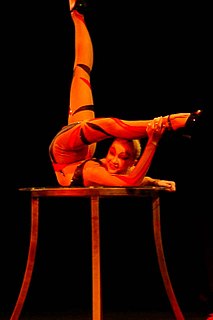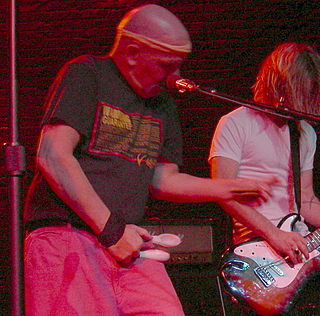This article needs additional citations for verification .(September 2015) |
The detachable thumb (unknown originator) is a close-up illusion.
This article needs additional citations for verification .(September 2015) |
The detachable thumb (unknown originator) is a close-up illusion.
The performer appears to remove the end of his own thumb; moving it back and forth along his hand or lifting it up.
There is no particular secret to this illusion: the performer simply holds out one hand sideways with the palm out and the tip of the thumb folded down behind the hand. Then, they places their other thumb bent so that the tip appears to be connected to the folded-down thumb with the forefinger bent to cover the joint. [1]

Clawhammer, sometimes called frailing, is a distinctive banjo playing style and a common component of American old-time music.

Contortion is a performance art in which performers called contortionists showcase their skills of extreme physical flexibility. Contortion acts often accompany acrobatics, circus acts, street performers and other live performing arts. Contortion acts are typically performed in front of a live audience. An act will showcase one or more artists performing a choreographed set of moves or poses, often to music, which require extreme flexibility. The physical flexibility required to perform such acts greatly exceeds that of the general population. It is the dramatic feats of seemingly inhuman flexibility that captivate audiences.

A mudra is a symbolic or ritual gesture or pose in Hinduism, Jainism and Buddhism. While some mudras involve the entire body, most are performed with the hands and fingers.

Card manipulation is the branch of magic that deals with creating effects using sleight of hand techniques involving playing cards. Card manipulation is often used in magical performances, especially in close-up, parlor, and street magic. Some of the most recognized names in this field include Dai Vernon, Tony Slydini, Ed Marlo, S.W. Erdnase, Richard Turner, John Scarne, and Ricky Jay. Before becoming world-famous for his escapes, Houdini billed himself as "The King of Cards". Among the more well-known card tricks relying on card manipulation are Ambitious Card, and Three-card Monte, a common street hustle also known as Find the Lady.
Several manual alphabets in use around the world employ two hands to represent some or all of the letters of an alphabet, usually as a part of a deaf sign language. Two-handed alphabets are less widespread than one-handed manual alphabets. They may be used to represent the Latin alphabet or the Cyrillic alphabet.

The sign of the horns is a hand gesture with a variety of meanings and uses in various cultures. It is formed by extending the index and little fingers while holding the middle and ring fingers down with the thumb.

A thumb tip is a magician's prop designed to fit over and appear to be the magician's thumb used for vanishing, producing, or switching small objects. A classic effect is to have a silk handkerchief or other small object pressed into the top of the left fist. After pushing it well in with the right thumb, the left fist is opened to show the silk has disappeared. Alternatively, a lit cigarette, liquid, salt or other small objects can be made to disappear in a similar manner.
This is a glossary of conjuring terms used by magicians.

Plains Indian Sign Language (PISL), also known as Plains Sign Talk, Plains Sign Language and First Nation Sign Language, is a trade language, formerly trade pidgin, that was once the lingua franca across what is now central Canada, the central and western United States and northern Mexico, used among the various Plains Nations. It was also used for story-telling, oratory, various ceremonies, and by deaf people for ordinary daily use. It is thought by some to be a manually coded language or languages; however, there is not substantive evidence establishing a connection between any spoken language and Plains Sign Talk.
Fearson's floating cigarette is a magical illusion created by Steve Fearson in the early 1990s.
Glorpy, sometimes known as the Haunted Handkerchief, is a close-up magic trick. The effect is that a ghost or spirit is captured in a folded handkerchief that then makes the handkerchief move. This effect is also used in demonstrations of spirit writing when shown in a seance or mentalism context. Simple versions have been performed for years. A modern version by Bill Madden and Bernie Trueblood was created circa 1960 and declared the "Trick of the Millennium" by Genii, the conjurer's magazine.
American Sign Language (ASL), the sign language used by the deaf community throughout most of North America, has a rich vocabulary of terms, which include profanity. Within deaf culture, there is a distinction drawn between signs used to curse versus signs that are used to describe sexual acts. In usage, signs to describe detailed sexual behavior are highly taboo due to their graphic nature. As for the signs themselves, some signs do overlap, but they may also vary according to usage. For example, the sign for "shit" when used to curse is different from the sign for "shit" when used to describe the bodily function or the fecal matter.
Origami is a magic stage illusion with a Japanese paperfolding theme, designed by Jim Steinmeyer. It was originally performed in 1986 by Canadian illusionist Doug Henning, using a working prop constructed by illusion builder John Gaughan. Illusionist David Copperfield later introduced presentational changes that would be widely copied by other performers.

Spoons can be played as a makeshift percussion instrument, or more specifically, an idiophone related to the castanets. They are played by hitting one spoon against the other.
Impaled is a classic stage illusion in which a performer appears to be impaled on or by a sword or pole. The name is most commonly associated with an illusion that was created by designer Ken Whitaker in the 1970s and which is sometimes also referred to as "Beyond Belief" or "Impaled Beyond Belief". This version has become part of the stage magic repertoire and has been performed by many of the world's most famous magic acts.

In dance and gymnastics, a turn is a rotation of the body about the vertical axis. It is usually a complete rotation of the body, although quarter (90°) and half (180°) turns are possible for some types of turns. Multiple, consecutive turns are typically named according to the number of 360° rotations.

A levitation illusion is one in which a magician appears to defy gravity by making an object or person float in the air. The subject may appear to levitate unassisted, or it may be performed with the aid of another object in which case it is termed a "suspension".

An Esperanto manual alphabet is included as part of the Signuno project for manually coded Esperanto. Signuno is based on the signs of Gestuno, but adapted to the grammatical system of Esperanto.